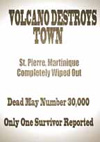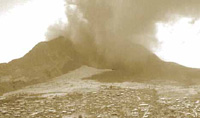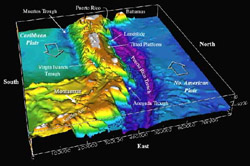 |
Volcanoes
Maybe
being in jail, this one time, was a stroke of luck.
 The
year was 1902. For over a century, the town of St. Pierre on
the island of Martinique had been known as the “Paris
of the Caribbean." Ships of all sizes sailed into the port.
Beautiful homes, furnished with elegant furniture and works
of art, hinted of the vast fortunes that had been made on the
islands from the trade of cotton, tobacco and sugar. The latest
Paris fashions adorned the women who walked arm in arm on St.
Pierre's quiet streets. In the background, high above the luxurious
homes and strollers on the boulevards loomed the majestic, deep-green
Mount Pelèe.— The
year was 1902. For over a century, the town of St. Pierre on
the island of Martinique had been known as the “Paris
of the Caribbean." Ships of all sizes sailed into the port.
Beautiful homes, furnished with elegant furniture and works
of art, hinted of the vast fortunes that had been made on the
islands from the trade of cotton, tobacco and sugar. The latest
Paris fashions adorned the women who walked arm in arm on St.
Pierre's quiet streets. In the background, high above the luxurious
homes and strollers on the boulevards loomed the majestic, deep-green
Mount Pelèe.—
The month was May. For weeks, minor rumblings,
small showers of ash, and the stench of sulfur had caused great
concern among the townspeople. The governor, believing these
rumblings were little more than the mountain's "clearing
of the throat," gave cheerful pep talks to the residents
to convince them to remain in St. Pierre.
 The
day was the 8th. Suddenly, a chaotic mixture of flame, ash,
and gas erupted through a vent in Mt. Pelèe's summit,
descended down its slopes at 160 kilometers per hour, and slammed
into the town of St. Pierre. Within minutes a burning cloud
of poisonous gases swept over the town and the harbor, setting
ablaze the ships anchored there. Of the 28,000 people estimated
to be in the town at the time, only three survived. One survivor
was a convicted murderer temporarily housed in the jail. The
jail's massive, partially underground walls repelled the searing
heat and protected this lucky man from Mt. Pelèe's wrath.
Another survivor, a small girl, hid in a cave on the coast. The
day was the 8th. Suddenly, a chaotic mixture of flame, ash,
and gas erupted through a vent in Mt. Pelèe's summit,
descended down its slopes at 160 kilometers per hour, and slammed
into the town of St. Pierre. Within minutes a burning cloud
of poisonous gases swept over the town and the harbor, setting
ablaze the ships anchored there. Of the 28,000 people estimated
to be in the town at the time, only three survived. One survivor
was a convicted murderer temporarily housed in the jail. The
jail's massive, partially underground walls repelled the searing
heat and protected this lucky man from Mt. Pelèe's wrath.
Another survivor, a small girl, hid in a cave on the coast.
Vulcan's workshops
Volcanoes have been erupting on Earth
since its creation. Evidence shows they have erupted on other
planets and moons in our solar system as well. For hundreds
of years volcanic mountains sit quietly — regal backdrops
to the people who live in their shadows. Then they come alive,
perhaps spewing only small amounts of ash, steam, and gas into
the atmosphere; perhaps erupting in great violence. The Romans
believed that volcanoes were the subterranean workshops of Vulcan,
god of fire and metalworking. The name of this Roman god gave
rise to the English word, "volcano."
A volcano is a vent, or opening in
the crust of the Earth from which pours molten rock, rock debris,
gases, and steam from deep within our planet. It works as a
giant plumbing system through which pent-up materials held prisoner
in the Earth's crust can escape to the surface. Over many years,
a cone of solidified volcanic material grows larger and larger
as the materials accumulate around the vent.
Would you consider a volcano to be more constructive
or destructive? To scientists, volcanoes are known as “constructive”
forces. That is, volcanoes often result in the construction
of new landforms. “Destructive” forces are those
like erosion or weathering in which landforms are broken down
into smaller pieces like soil and sand. The process of rock
formation and break down is part of the “rock cycle.”
Volcanoes contribute to the rock cycle by bringing molten rocks
to the surface to create new landforms. Over the ages, these
landforms weather and erode, creating sediments that may be
buried, then compacted, heated, remelted and recrystallized
to form new rock. Eventually, those new rocks may be brought
to the surface again and the cycle begins anew.
With enough volcanic “construction”,
a mountain is formed. Some volcanic mountains form on continental
land masses. Other volcanic mountains build from the bottom
of the sea to become islands that dot the oceans of the Earth.
The island of Martinique is one such island.
 Underwater shaded relief map
of a portion of the Caribbean including Puerto Rico and islands
extending East and South down to Montserrat. Martinique is not
shown. Note the landforms resulting from the volcanic processes
in this area (colored green, orange, yellow and white). Those
portions above water are shown in white and appear on maps as
islands. Many scientists believe the volcanic activity in this
area is due to the North American plate sliding past and underneath
the Caribbean plate (see arrows). Image courtesy of USGS.
Underwater shaded relief map
of a portion of the Caribbean including Puerto Rico and islands
extending East and South down to Montserrat. Martinique is not
shown. Note the landforms resulting from the volcanic processes
in this area (colored green, orange, yellow and white). Those
portions above water are shown in white and appear on maps as
islands. Many scientists believe the volcanic activity in this
area is due to the North American plate sliding past and underneath
the Caribbean plate (see arrows). Image courtesy of USGS.
Move over, Everest.
The now-dormant Mauna Kea volcano in Hawaii, usually snow-capped
in winter, measures 9,754 m from sea floor to peak, making
it the world's highest mountain. Everest is a mere 8,848
m high. However, it must be noted, only the uppermost 4,205
m of Mauna Kea is above water.
How many?
There are some 1,300 potentially active volcanoes in the
world today.
|

Review Questions
- Describe three ways in which volcanoes are destructive.
- Describe three ways in which volcanoes are constructive.
- Think for a minute. Why would people choose to live in an
area of volcanic activity?
|
 |